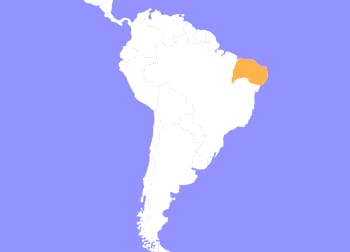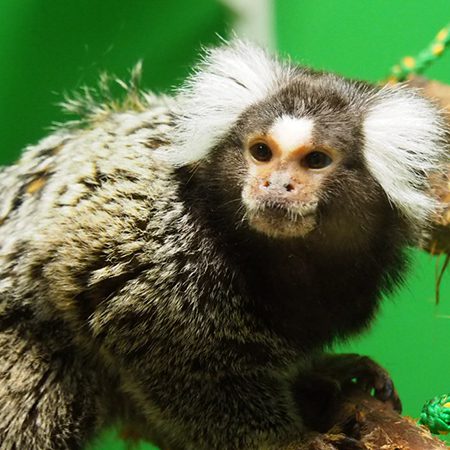Common Marmoset
Callithrix jacchus
The common marmoset is known as a New World Monkey. The term New World refers to the Americas inclusive of North, South and Central America. Old World contrasts referring to regions of Asia, Africa, and Europe. These guys live on the northeastern coast of Brazil, in tropical humid environments.
Common marmosets are very small monkeys with relatively long tails. Both the males and females are similar in size, with the male being slightly larger. Males have an average height of 7.4 inches, with females being 7.2 inches. Males typically weigh around 9.03 oz, with females weighing 8.32 oz on average. A marmosets pelage (fur) is multicolored, being sprinkled with browns, greys, and yellows. They also have white ear tufts, a banded-colored tail, black coloring that covers the nose, and a white crest on the forehead. When they are first born, marmosets don’t have their ear tufts, they develop a little later.
Marmosets have an arboreal locomotion, using its tiny claws to hang, jump, and run across forest canopies. While they are native only to Brazil, they have been introduced to other areas of the country and Argentina. Marmosets are able to get all of their nutrition from the forests they inhabit. They have a unique diet primarily made of plant material and insects. Gum, sap, latex, and resin of fauna are commonly eaten by marmosets in the wild. In the wild they live in stable social organizations of extended families. Groups can contain as many as 15 members, with 1-2 designated breeding females, a breeding male, and their offspring and adult relatives.
Say Hello To Cub Creek's Marmoset: Cricket
Cricket was born on March 3rd, 2013. Cricket is one of our most popular encounter animals for those campers who have reached their 7th year and beyond of camp. He loves to sit on your shoulder and just watch what you are doing. His favorite thing is the help with food prep and tell you what goes in each box. You can find Cricket in the jungle hopping from tree to tree. Cricket enjoyed a gelatin cake made especially for his 6th birthday this year.

Common Marmosets originate from the Eastern coast of Brazil.
HABITAT -They inhabit forest canopies of South America, ranging from Brazil and Argentina.
DIET -They will eat plant material, fruit, and insects.
FUN FACT -The common marmoset is the first new world monkey to have its genome sequenced.
SOCIAL BEHAVIOR -They have social organization living in groups in the wild.
ACTIVITY -Common marmosets are diurnal, being most active during the day and sleeping at night.
PREDATORS -Predators of the common marmoset include mustelids, felids, arboreal snakes, owls, and raptors.
SIZE -Males have an average height of 7.4 in, with females being 7.2 in; males typically weigh 9.03 oz, with females weighing 8.32 oz.
RELATIVES -There are twenty-two known New World monkey species comprised of the genera Callithrix, Cebuella, Callibella, and Mico.
CONSERVATION -The common Marmoset is considered Least Concern on the IUCN Red List.
Cub Creek Animal Care Information
Housing - Our common marmoset is housed in a large indoor enclosure that has plenty of room for him to jump around, explore, and hang out. The enclosure is designed to promote a simulated natural environment with tree branches, limbs, and foliage covering his space. There are also wooden perches, boxes, ropes, and chains, that he loves to play on. There are parts of his enclosure where wooden boxes are used as a safe space / hide for him, it’s lined with blankets to make sure it's comfortable. And of course, we provide a way for him to get fresh clean water all the time.
Diet - We feed our Common marmoset a well balanced diet consisting of mixed vegetables, apples, and bananas. His diet is supplemented with Marmoset Jelly, an easy to prepare food that meets the high-protein, high-energy needs of primates. We combine the marmoset jelly with another supplement of Callitrichid High Fiber Diet, providing high-fiber nutrition for insectivorous primates. When feeding them this mixture, we’ll use mango nectar or yogurt to mix these supplements making it more palatable. Some of their favorite treats include dry fruit like raisins!
Enrichment - Our common marmoset is well accustomed to human interaction, being comfortable leaping onto shoulders, and transferring between handlers. Much of this can be attributed to the continual enrichment through training, and social interaction with humans. During the summer, campers will make all kinds of toys for our marmoset, made out of cardboard, or pre made materials. Stuffed animals are a favorite toy for our marmoset, they’ll cuddle up with their favorite stuffed animal when they go to sleep. Special treats are also given to our marmoset, like special fruit gelatin cakes on their birthday!

